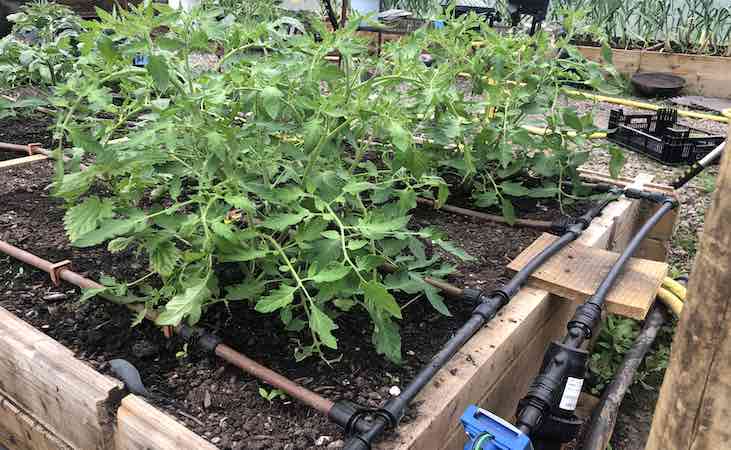Early May in the vegetable garden

The news from the Quickcrop garden could be described as 'mixed'. Outside, a mind boggling amount of slugs continue to eat everything in sight despite my best efforts at control. On a more positive note, the (almost) slug free tunnel is flying along: we have garlic nearly ready to harvest, peas producing pods and even the first fruits appearing on the early bush tomatoes. It is very tempting to switch to polytunnel growing altogether as it is so much easier but I can't forsake the outdoor garden and do have some plans for it (see the blog post below).

Tomato Maskotka
The two tomatoes above are the bush variety 'Maskotka' (which will be included in our new 2024 seed selection), they were planted nearly 2 weeks ago and have settled in well. I didn't notice it when I took the photo but there is also a nettle hiding in there which will have to be hoiked out this evening.
Maskotka is a very early bush tomato which is already setting fruit, I expect the first ripe tomatoes in the second week of June. Being a bush variety, there is no pruning (removing side shoots) required nor does the plant need any support. Bush varieties are also handy if you want to make passata in bulk for freezing as they produce a lot of fruit at the same time, usually a first flush followed by a lull and then a second harvest in late summer.

Maskotka is unusual for a bush as, if kept well fed, it will produce fruit throughout the season from an early start to very late autumn harvests. Bush varieties don't have the best reputation in some circles as they are said to have less flavour and tougher skins but this is certainly not the case here. Maskotka has a superb tomato flavour both for using fresh and for cooking, it has all the handy advantages of a bush type without any of the downsides.

Garlic Primor
The very pretty garlic in the photo is the hardneck 'Primor' that has already reached a decent size, I lifted one just now to see how far along we were. Hardnecks produce smaller bulbs than softneck varieties so the above isn't too shabby but I will leave them for another couple of weeks as I don't need the space right now.
If you are unsure about when to harvest garlic, you are better going too early rather than too late. It is commonly advised to wait for the leaves to yellow and die back but this is not best practice as it means the protective sheath around the bulbs is also dying back.
Garlic should be harvested while the leaves are still green to ensure you have a good few papery layers covering the individual cloves, this will increase the storage life of the bulb. Garlic grown undercover will generally be harvested in early June while outdoor crops are lifted 2-3 weeks later.
By the way, garlic doesn't look as clean as the photo when you harvest it, you need to remove the first layer of skin to reveal the pristine bulb underneath.

Spinach Mikado F1
Annual spinach is more of a late summer/autumn crop because its flowering period is late spring and early summer when it is guaranteed to run to seed. The alternative is to grow perpetual spinach which is a biennial so goes to seed in the second year after it is sown but the flavour is very different (perpetual spinach is actually a chard).
I find Oriental spinach varieties like Mikado F1 are a good compromise as they are slower to bolt so will give more leaf before they flower. the flavour and tenderness of the leaves are much closer to annual spinach while plants are also vigourous with multiple leafy side shoots.

Spinach Oriental 'Mikado' F1
View ProductFebruary sown Calabrese
A mixture of red and green lettuce pictured above growing under calabrese plants that I sowed in February. Again, early sowing and planting in the tunnel shows its worth as the calabrese is now starting to produce heads. I also have some spring cabbage in the same bed which are also forming heads so I expect to start harvesting both in about 2 weeks time.
Calabrese is very well suited to early tunnel growing as it is a relatively fast maturing brassica and is ready to pick 12 weeks after sowing. For me this season, it means the beds will be empty again in early June leaving me a wide range of options to follow with e.g. lettuce,. sweetcorn, cucumber, beetroot or french beans.
